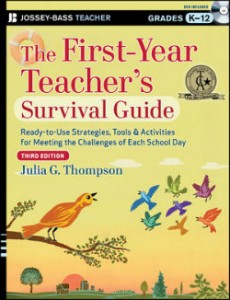The First-Year Teacher’s Survival Guide: An Essential Resource
The First-Year Teacher’s Survival Guide: Ready-to-Use Strategies, Tools & Activities for Meeting the Challenges of Each School Day (3rd Ed.)
By Julia G. Thompson
(Jossey-Bass/Wiley, 2013 – Learn more)
In the late 1980’s, Lee Shulman importantly outlined three kinds of knowledge for teachers: content knowledge, pedagogical knowledge, and pedagogical content knowledge. Our first-year teachers bring still-developing capacities in each of these areas to their new classrooms. Now consider all the other types of knowledge first-year (and even experienced) teachers need to acquire: knowledge of professional responsibilities; knowledge of new technologies; knowledge of students and communities, and more.
Put all of these professional learning needs together and you some idea of the breadth of content found in the newest edition of Julia Thompson’s The First-Year Teacher’s Survival Guide.

Each section in the book combines narrative explanation of the topic at hand with numerous checklists, examples, reminders, do’s and don’t’s, and Teacher Worksheets.These Worksheets serve as planning guides and some are meant to be reproduced for repeated use (for example, the Teacher’s Daily To-Do List) while others are meant to help teachers organize and synthesize ideas (for example, Planning for Classroom Policies on topics like tardiness, cheating, or food in the classroom). Student Worksheets such as Assignment Reflection or Grade Tracking Form give teachers ideas for handouts for students. (The guide is aimed for teachers at all grade levels, so teachers may want to adapt some of the worksheets appropriately.)
Read it all or pick-and-choose
Even though the book is presented in a clear, linear fashion, many first-year teachers may not read it cover to cover but instead use it for specific reference or trouble shooting. Harry and Rosemary Wong encourage teachers in the opening pages of The First Days of School to use their book as a reference rather than read it start to finish, and this book would also work well in that role. For this book, the index would be more useful as a quick navigational tool than the table of contents as the headings and sub-headings are much more specific.
A sample page on “Activities for the First Day” gives several general ideas that may be familiar to teachers emerging from their preservice education and serve as good reminders of what they would like to do in their own classrooms. Also, many first-year teachers (much like student teachers I have known) are eager for highly specific examples, and Julia Thompson (still a practicing teacher in Virginia) offers specific ideas at many points. Templates for a lesson plan and a hall pass offer readers starting places that they may need to adjust to school or district requirements.
Along with the highly practical features, this book encourages reflection for first-year teachers. Because my own background emphasizes teacher vision and being a reflective teacher, I compliment Julia Thompson on ending sections with prompts for reflection. After the section on Designing Effective Instruction, one prompt is: “How can you tell when your lessons are engaging and appropriate for your students? What specific activities can you include to make sure your lessons are interesting and challenging?” For Discipline Problems, the first-year teacher is asked, “How can you tell whether a student is self-disciplined? What can you do to promote this trait in your students?”
This book is designed to help a first-year teacher survive and thrive.
The power of the “obvious”
If I had been handed this book before my first year in the classroom, I may have wondered why I would need a survival guide that is more than 500 pages long. The reasons would have become more apparent as the year progressed.
In Thompson’s 500+ pages, there are a few points that some readers may find very obvious, such as “Parents and guardians should see you as a friendly and knowledgeable teacher who has their child’s best interests at heart.” But, as I tell my preservice students, never underestimate the power of the obvious. First-year teachers have a lot going on, so it can be helpful, rather than glib or condescending, to include generalities along with more detailed and specific information.
I recommend this book for first-year teachers, and I also recommend it for teacher educators, cooperating teachers, or others who work with preservice and novice classroom educators. The many Teacher Worksheets and the Time to Reflect sections, along with other aspects of the book, could be easily adapted to teacher education courses.
Readers who enjoy this book may also like Wong and Wong’s The First Days of School, Saphier and Gower’s The Skillful Teacher, Doug Lemov’s Teach Like a Champion, or Rafe Esquith’s Teach Like Your Hair’s on Fire as well. As you begin our challenging profession, can you really have too much help?
Read another review of this book by a first-year teacher.
Amanda Wall is an assistant professor in the Department of Teaching and Learning at Georgia Southern University. Her research interests include motivation in the middle grades. For 12 years, she taught Latin and Writing in grades 5-12, spending most of her years in middle schools. Her articles for MiddleWeb can be found here.




































